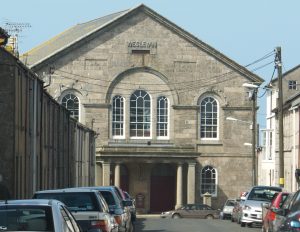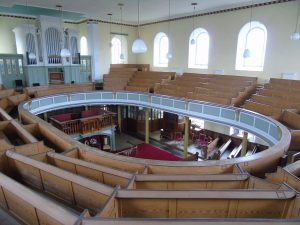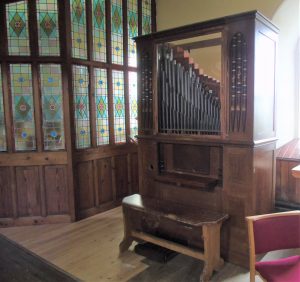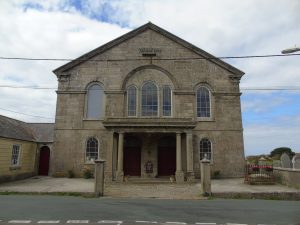
St Just, known as St Just in Penwith, is the most westerly town in mainland Britain and is situated approximately 8 miles (13 km) west of Penzance. This profile of St Just Wesleyan Chapel has been compiled by Jo Lewis and Tony Mansell.
John and Charles Wesley preached regularly in St Just between 1743 and 1789 and in 1750 John Wesley noted that “the society of St Just was the largest in Cornwall”. (Penwith Local History Group)
In 1744 Charles Wesley noted it was crowded with the allegedly schismatical Methodists. (A Dictionary of Methodism)
On Sundays the society members attended the parish church. ‘The Old Schoolroom’ in Cape Cornwall Street is now a private house. The older part of this building replaced the North Row society house in 1755. Wesley preached from its foundation stone on 13 September. When he returned to preach there two years later he thought it to be ‘the largest and most commodious in the county’. In 1799 it was extended towards the town, the new part becoming the Wesleyan chapel and the old part the schoolroom. After 1833, when the present Methodist church was opened, the Cape Cornwall Street property became the schoolroom, and is now a private house. The present Methodist Church (1833), at the end of Chapel Street, still dominates the town.
The cross at the entrance to the churchyard
Both John and Charles Wesley preached by the cross at the entrance to the churchyard. (A Dictionary of Methodism)
The Plen an Gwary
John Wesley preached in the ‘plen an gwary’, the open air arena where performances have taken place through the ages. (A Dictionary of Methodism)
William Chenhalls’ House
John’s host in the town was the innkeeper, William Chenhalls (1693-1780), whose house with its three dormer windows stands opposite the churchyard gate. Here was the first home of the Methodist society in the town. (A Dictionary of Methodism)
North Row Meeting Place
The house in North Row, now called “The Meeting Place” was already in use as a Methodist society house when Charles Wesley was there in 1746 and it continued to serve the society for class meetings and weekday preaching services until 1755. (A Dictionary of Methodism)
An C18 Wesleyan meeting house, probably the earliest surviving Methodist building in Cornwall, is now used as a house and a meeting room. Granite rubble with granite dressings under a scantle slate roof; brick end stacks. The original arrangement was probably with a central doorway to the ground floor. The first-floor openings have been remodelled; all window openings with C20 sashes except for first-floor doorway at far right approached by straight flight of granite steps. Granite rubble and dressed granite road-frontage walls. It is a very important building in the history of Methodism in Cornwall. (Cornwall Heritage Gateway)
1746: In use as a Meeting Place. (A Dictionary of Methodism)
The society members attended the parish church on Sundays.
1755: The building ceased its use as a meeting place when the new chapel opened.
1755 Chapel
The Old Schoolroom’ in Cape Cornwall Street is now a private house (picture awaited) The older part of this building replaced the North Row society house in 1755. Wesley preached from its foundation stone on 13 September. When he returned to preach there two years later he thought it to be ‘the largest and most commodious in the county’.
A Methodist Society house from 1755 has been remodelled and extended with a Sunday school added in the C19. It is now converted to house but retaining galleried interior. Dressed granite front brought to course; coped scantle slate roofs and crested and pierced clay ridge tiles. It has Italianate style front with round-arched openings, the front gable end with a group of 3 windows over a gabled porch flanked by two windows with margin-pane fanlight heads. Low forecourt walls and granite gate-piers. Listed in Stell (b1). Used as a school from 1877 (b1) and recorded as a school for boys and girls on the 1st Edition 1:2500 1880 OS map. The school was relocated immediately to the west to the school’s current location (see 175474) sometime after 1880 but before 1907.
13th September 1755: Wesley preached from its foundation stone.
1755: Build date.
1799: Extended towards the town, the new part becoming the Wesleyan chapel and the old part the schoolroom.
Speaking of St Just, Mr Hobson says, “The houses of prayer, in the different parts of the parish, all became too small for the congregations; and hence they made use of the largest barns in the neighbourhood. At one place, Nanquidno The péople used to worship in a dwelling house but on Friday the barn could not con tain them. Not one half of the peo- ple could gain admittance so they held their prayer-meeting by moon light, upon the moor, by the sea-side. (From the Christian Observer and Methodists 1833 – Provided by Barry West)
After 1833, when the present Methodist church was opened, the Cape Cornwall Street property became the schoolroom, and is now a private house.
“If we except the erection of an end-gallery in the church-town chapel, which took place in 1818, nothing remarkable remains to be recorded of the St. Just society, till the great revival of 1832-1833; an account of which the reader will find in the following pages. In consequence of the increase which thus accrued to the societies and congregations, it became necessary to build three new chapels. Of these, in the order of time, the first was at Nanquidno, a place about two miles to the south of the church-town, where up to this period no similar accommodation had been required. This situation is remarkably bold, and is traditionally connected with some interesting historical asso- cations, particularly the landing of Stephen and of John on his return from a visit to Ireland. To the north lies the noble promontory of Cape Cornwall; and to the south, opposite the Land’s End, the rocks called the Long Ships, with their lighthouse. In the centre of this wild scenery, and exposed to the Atlantic winds, our small but substantial chapel is erected.” (Memoirs of Mr John Edwards Trezise of St Just – Extract from his Diary with some account of Methodism in St Just by Richard Treffrey Jun.)
1877: Became a school.
Became a private house.
1830s Chapel

A large Wesleyan chapel, widened (to left), lengthened (at rear) and heightened in 1860, Sunday school addition attached to the left, plus some refitting in 1893 (ground-floor pews). It has a granite ashlar front, otherwise granite rubble with granite dressings. 1860 remodelling of the front carried out in Italianate style. Original or 1860 sash windows (most with fanlight heads) throughout and 1860 panelled doors. 3-bay symmetrical front has open pediment and 1:3:1 lights (within recessed round-arched panels) over pair of doorways within distyle-in-antae Tuscan porch, the porch flanked by two smaller sash windows. Fine interior has good ceiling roses and full 1860 gallery with 1860 box pews. Good rostrum possibly incorporating part of earlier pulpit, painted texts and other interesting features in canted communion apse with round communion window. From some directions this is the most prominent building on the skyline of St just and must have been one of the last buildings to be seen by emigrants to America after they had passed Land’s End. Listed and illustrated in Stell (b1). (Cornwall Heritage Gateway)
1833: Build date. (Cornwall Heritage Gateway / SWChurches)
Built as a Wesleyan Chapel. (SWChurches)
Reporting the opening of the Chapel, the, announced that there was seated accommodation for 1800 worshippers (possibly an over-statement). (Royal Cornwall Gazette of 5th October 1833)
Part of St Just Wesleyan Circuit, (SWChurches)
1932: The Wesleyan, Primitive Methodist and the United Methodist Church amalgamated to become the Methodist Church of Great Britain.
1932: Became Chapel Street Methodist Church. (SWChurches)
Part of St Just Methodist Circuit. (SWChurches)
27th September 1833: The Chapel, often referred to as the Miner’s Cathedral, opened its doors for worship. (Penwith Local History Group)
1851: The Religious Census of West Cornwall and the Isles of Scilly reported that the morning service was often attended by 650 while the figure in the evening was frequently over 1000. The actual figures for Sunday March 30th 1851 were 650 in the congregation in the morning and 900 in the evening. The census also reported that St Just, population 5,559 (not including Pendeen), contained 950 people giving their denomination as Church of England; 1390 Wesleyans; and 700 Bible Christians. The same source gives of 1000 for seating and this was clearly only just adequate! (Penwith Local History Group)
1851: E. I. Sturges was minister.
1873: Survey reports 1650 seats.
1892: “St. Just Wesleyan Chapel. The chapel is to be re-seated, the old ones being replaced by pitch pine seats. The chapel throughout is to be painted and decorated; a heating apparatus is to be put in; and the chapel is to be lighted by stay lights from the ceiling…” (Royal Cornwall Gazette – Thursday 26 May 1892)
 1950s: St Just Tea Treat (Photo courtesy Paul Phillips)
1950s: St Just Tea Treat (Photo courtesy Paul Phillips)
1960: Re-opening of organ. (West Briton and Cornwall Advertiser – Thursday 21 April 1960)
After 184 years the dwindling congregation was no longer able to support the cost of the huge building. (Penwith Local History Group)
2016: Following the announcement of closure in April there were various discussions and proposals regarding the future of the building. (Penwith Local History Group)
25th April 2016: A notice was posted that the Wesleyan Methodist Chapel was to close its doors for the last time at midnight on Thursday 31st August 2017. (Penwith Local History Group)
 (Photo: Barry West)
(Photo: Barry West)
The following five photographs were provided by Colin Retallick





Became a community hub and place of prayers.

It was only recently called the Miners Chapel at the time of the levant Minde disaster it was called the Miners Cathedral as was a place where miners were buried and managers worshipped. It remains a Methodist chapel but the work of the community to protect the building cannot be underestimated